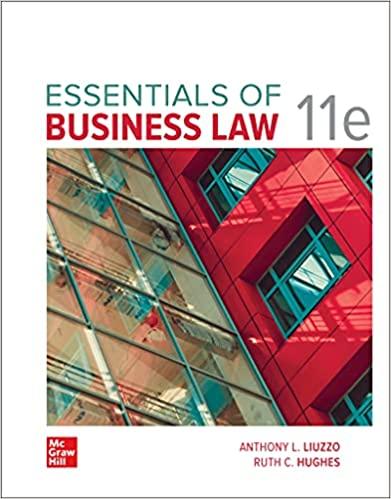Question
Description Your Assignment is to: (with your name on it), 1. Analyze each of these threecases in your mind and then state the legal issues
Description
Your Assignment is to: (with your name on it),
1. Analyzeeach of these threecases in your mind and then state the legal issues to be considered.
2. Evaluate the legal issues in this case and determine the strengths and weaknesses of (a.) the suit by the Plaintiff against the defendant. List the strengths and weaknesses you identify.
3. Deduce logical and specific arguments based on the information you have learned in the Chapters we have covered for this test of your textbook and what you have learned in this course. (I am looking for verifiable deductions from the material we have covered and not just your opinion). You also must cite the source which is the basis for your deduction such as the cases or the writings that are similar which we have covered. You may also seek and cite outsource reputable sources.
4. Infer and state your logical legal conclusions based on your analysis, evaluations, and evidence you have previously stated. This legal conclusion should include (a.) who should win the law suit, and legally why and (b.) who should win the law suit.
Case #3- Ford Motor Company was formed in 1903. Henry Ford, the president and owner of most of the firm's stock, attempted to run the corporation as if it were a one-person operation. The firm expanded rapidly and, in addition to regular quarterly dividends, often paid special dividends. Originally, the Ford car sold for more than $900. From time to time, the price was reduced, and in 1916 it sold for $440. For the year beginning August 1, 1916, the price was reduced again to $360. In the interest of setting aside money for future investment and expansion, the firm announced that it would pay no special dividends after October 1915, even though surplus capital in 1916 exceeded $110,000,000. The minority stockholders, who owned one-tenth of the shares of the corporation, petitioned the court to compel the directors to declare a dividend. The lower trial court held for the minority stockholders, and the other stockholders appealed to the higher court. What should the higher court hold as to the legal issue here? Does a corporation have to declare a dividend? If so, what is the legal basis for this requirement? Substantiate your answer by legal reasoning. What is the legal basis for the majority stockholders decision not to pay a dividend? Explain this defense.Dodge v. Ford Motor Co.,Supreme Court of Michigan, 170 N.W. 668 (1919).
Step by Step Solution
There are 3 Steps involved in it
Step: 1

Get Instant Access to Expert-Tailored Solutions
See step-by-step solutions with expert insights and AI powered tools for academic success
Step: 2

Step: 3

Ace Your Homework with AI
Get the answers you need in no time with our AI-driven, step-by-step assistance
Get Started


